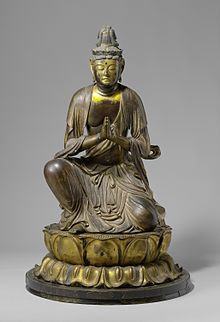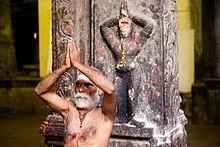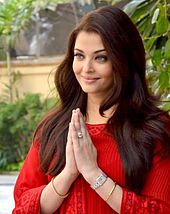Añjali Mudrā: Difference between revisions
this should have been discussed; and the comment about unreferenced is plainly false, specially as the refs have been copied into the target article |
revert, rm tag, add secondary RS Tag: Removed redirect |
||
| Line 1: | Line 1: | ||
[[File:Añjali Mudrā (Praṇāmāsana).jpg|right|thumb|upright|Statue with hands in most common Anjali Mudra position.]] |
|||
#REDIRECT [[Namaste#Añjali_Mudrā]] |
|||
[[File:Bodhisattva Seishi, met sokkel-Rijksmuseum AK-MAK-119.jpeg|thumb|A Japanese statue of Bodhisattva Seishi, doing Añjali Mudrā.]] |
|||
'''Añjali Mudrā''' ({{lang-sa|अञ्जलि मुद्रा}}) is a hand gesture, associated with [[Indian religions]] and arts, practiced throughout [[Asia]] and beyond. It is a part of Indian classical dance postures such as [[Bharatanatyam]],<ref name="Anami Bhandage31021–31040">{{cite journal | last=Anami | first=Basavaraj S. | last2=Bhandage | first2=Venkatesh A. | title=A vertical-horizontal-intersections feature based method for identification of bharatanatyam double hand mudra images | journal=Multimedia Tools and Applications | publisher=Springer Science | volume=77 | issue=23 | date=2018-06-04 | issn=1380-7501 | doi=10.1007/s11042-018-6223-y | pages=31021–31040}}</ref> yoga practice,<ref name="CarrollCarroll2012">{{cite book|author1=C Carroll|author2=R Carroll|title=Mudras of India: A Comprehensive Guide to the Hand Gestures of Yoga and Indian Dance|url=https://books.google.com/books?id=Fn_c9wbLIeAC&pg=PA44|year=2012|publisher=SD Publishers|isbn=978-0-85701-067-4|pages=44–46}}</ref> and a part of the greeting [[Namaste]]. Among the performance arts, Anjali Mudra is a form of non-verbal expression of the underlying story or a visual communication to the audience. It is one of 24 samyukta mudras of the Indian classical arts.<ref name="Anami Bhandage31021–31040"/> There are several forms of the Anjali Mudra such as the ''brahmanjali''.<ref name=gonda65>{{cite book|author=Jan Gonda|title=Handbuch Der Orientalistik: Indien. Zweite Abteilung|pages=65-67, 126-130|publisher=Brill Academic|year=1980|isbn=9789004062108}}</ref> |
|||
The gesture is incorporated into many yoga [[asanas]].<ref name="CarrollCarroll2012"/> The [[modern yoga]] pose '''praṇāmāsana''' ({{lang-sa|प्रणामासन|links=no}}) consists of standing with the hands in Añjali Mudrā. |
|||
As a gesture, it is widely used as a sign of respect or a silent greeting in [[India]], [[Sri Lanka]], [[Nepal]], [[Bhutan]], [[Burma]], [[Thailand]], [[Laos]], [[Cambodia]] and [[Indonesia]], also used among [[East Asia]]n Buddhists, Taoists and Shintoists and adherents of similar Asian traditions. The gesture is also used as a part of prayer or for worship in many [[Indian religions]] and [[Eastern religions]]. In sculpture, the Anjali mudra is common at entrances and in relief works of historic temples such as the Lingobhavamurti of [[Shaivism]].<ref>{{cite journal|author = Douglas Barrett| title= An Early Cola Lingodbhavamurti|journal = The British Museum Quarterly| volume= 28| number= 1/2 (Summer) |year= 1964| pp= 32-39|jstor=4422848}}</ref> The Anjali mudra differs from Namaste by being a non-verbal gesture, and Namaste can be said without any gesture. According to Bhaumik and Govil, the Anjali mudra and Namaskara mudra are very similar but have a subtle difference. The back of the thumbs in Anjali mudra face the chest and are perpendicular to other fingers, while the thumbs in Namaskara mudra are aligned with the other fingers.<ref name="BhaumikGovil2020">{{cite book | last=Bhaumik | first=Gopa | last2=Govil | first2=Mahesh Chandra | title=Communications in Computer and Information Science | chapter=Buddhist Hasta Mudra Recognition Using Morphological Features | publisher=Springer Singapore | publication-place=Singapore | year=2020 | isbn=978-981-15-6314-0 | issn=1865-0929 | doi=10.1007/978-981-15-6315-7_29 | pages=356–364}}</ref> |
|||
==Etymology== |
|||
''Añjali'' (अञ्जलि) is a [[Sanskrit]] word which refers to the cavity formed between the palms by folding the hands together, to thus hold and offer flowers or water or donate or to receive something.<ref name=gonda65/><ref>{{cite book|url=https://archive.org/stream/practicalsanskri00apteuoft#page/n43/mode/2up|author=VS Apte|year=1965|page=25|title=Practical Sanskrit-English dictionary}}</ref> When the hands press together and are raised, it connotes "respect", "reverence", "benediction", "salutation" or a form of "supplication". It is derived from ''anj'', meaning "to honour or celebrate".<ref name=yj1 /> ''Anjali'' connotes a "divine offering", "a gesture of reverence".<ref name=yj1 /> |
|||
''[[Mudra]]'' means "seal" or "sign". The meaning of the phrase is thus "salutation seal".<ref name=yj2>{{cite web |last=Rea|first=Shiva|title=For Beginners: Anjali Mudra|publisher=Yoga Journal|url=http://www.yogajournal.com/basics/145|accessdate=2009-06-12| archiveurl= https://web.archive.org/web/20090611095440/http://www.yogajournal.com/basics/145| archivedate= 11 June 2009 | url-status= live}}</ref> |
|||
The gesture is also known as ''hrdayanjali mudra'' meaning "reverence to the heart seal" (from ''hrd'', meaning "heart") and ''atmanjali mudra'' meaning "reverence to the self seal" (from ''atman'', meaning "self").<ref name=yj1/> |
|||
==Description== |
|||
[[Image:Indian sadhu performing namaste.jpg|thumb|left|A [[sadhu]] performing Anjali Mudra at his crown chakra in front of a sculptured figure in the same posture]] |
|||
Anjali mudra is performed by pressing the palms of the hands together. The fingers are together with fingertips pointing up. The hands are pressed together firmly and evenly.<ref name=yj1>{{cite web |title=Salutation Seal|publisher=Yoga Journal|url=http://www.yogajournal.com/poses/484|accessdate=2002-06-12}}</ref> |
|||
In the most common form of anjali mudra, the hands are held at the [[Anahata|heart chakra]] with thumbs resting lightly against the [[sternum]].<ref name=yj1 /> The gesture may also be performed at the [[Ajna]] or [[brow chakra]] with thumb tips resting against the "third eye" or at the [[Sahasrara|crown chakra]] (above the head). In some yoga postures, the hands are placed in anjali mudra position to one side of the body or behind the back. |
|||
Anjali mudra is normally accompanied by a slight bowing of the head. |
|||
{{clear}}<!-- prevents untidy half-wrap on next section --> |
|||
==Symbolic meaning== |
|||
[[File:AishwaryaRai09.jpg|thumb|upright|[[Aishwarya Rai]] making a Namaste gesture]] |
|||
Anjali mudra has the same meaning as the Sanskrit greeting ''[[Namaste]]'' and can be performed while saying ''Namaste'' or ''Pranam'', or in place of vocalizing the word. |
|||
The gesture is used for both greetings and farewells, but carries a deeper significance than a simple "hello" or "goodbye". The joining together of the palms is said to provide connection between the right and left hemispheres of the brain and represents unification.<ref name=yj1 /><ref name=yj2 /> This yoking is symbolic of the practitioner's connection with the divine in all things. Hence, performing anjali mudra is an honouring of both the self and the other as the gesture acknowledges the divinity of both practitioner and recipient. The sign is used to invoke the deepest respect that an individual may feel towards another entity that they may face, irrespective of age, gender, race or religion. The gesture 'Namaste' is the combination of 'Namah' and 'Te', which translates to 'the divine in me, bows to the divine in you', bringing down all your ego's and extending friendship during the good times and bad that we may face. <ref name=yj2 /> |
|||
In [[Sri Lanka]] the Sinhalese gesture of welcome incorporates the words "ayubowan" (may you live long) with both hands placed together on the sternum with a slight bow. |
|||
==Physical benefits== |
|||
Anjali mudra is performed as part of a physical yoga practice with an aim to achieving several benefits. It is a "centering pose" which, according to practitioners, helps to alleviate mental stress and anxiety and is therefore used to assist the practitioner in achieving focus and coming into a meditative state.<ref name=yj1 /> |
|||
The physical execution of the pose helps to promote flexibility in the hands, wrists, fingers and arms.<ref name=yj1 /> |
|||
==Use in full body asanas== |
|||
While anjali mudra may be performed by itself from any seated or standing posture, the gesture is also incorporated into physical yoga practice as part of many full-body asanas including: |
|||
* [[Anjaneyasana]] (lunge) - with arms overhead<ref>{{cite web |title=Low Lunge|publisher=[[Yoga Journal]] |url=http://www.yogajournal.com/poses/2494|accessdate=2009-06-12}}</ref> |
|||
* [[Hanumanasana]] (monkey pose)<ref>{{cite web |title=Monkey Pose|publisher=[[Yoga Journal]] |url=http://www.yogajournal.com/poses/874|accessdate=2009-06-12}}</ref> |
|||
* [[Garland Pose|Malasana]] (garland pose)<ref>{{cite web |title=Garland Pose|publisher=[[Yoga Journal]] |url=http://www.yogajournal.com/poses/2472|accessdate=2009-06-12}}</ref> |
|||
* [[Matsyasana]] (fish pose) - an advanced variant<ref>{{cite web|title=Fish Pose |publisher=[[Yoga Journal]] |url=http://www.yogajournal.com/poses/786 |accessdate=2009-06-12 |archiveurl=https://web.archive.org/web/20090618074755/http://www.yogajournal.com/poses/786 |archivedate=18 June 2009 |url-status=live }}</ref> |
|||
* [[Prasarita Padottanasana]] (wide-legged forward bend) - an advanced variant with hands behind the back<ref>{{cite web|title=Wide-Legged Forward Bend |publisher=[[Yoga Journal]] |url=http://www.yogajournal.com/poses/693 |accessdate=2009-06-12 |archiveurl=https://web.archive.org/web/20090611095508/http://www.yogajournal.com/poses/693 |archivedate=11 June 2009 |url-status=live }}</ref> |
|||
* [[Rajakapotasana]] (Pigeon Pose/King Pigeon Pose) - anjali mudra in Pigeon pose<ref>{{cite web |title=Pigeon Pose|publisher=Yoga Journal|url=http://www.yogajournal.com/article/beginners/pigeon-pose/|accessdate=2009-06-12}}</ref> |
|||
* [[Tadasana]]/samasthiti (mountain pose) - a variant of the pose used during [[sun salutation]] sequences<ref>{{cite web |title=Mountain Pose|publisher=Yoga Journal|url=http://www.yogajournal.com/poses/492|accessdate=2009-06-12}}</ref> |
|||
*[[Utkatasana]] (chair pose, literally "fierce pose"), arms overhead |
|||
* [[Urdhva Hastasana]] (upward salute/extended mountain pose) - arms overhead<ref>{{cite web |title=Upward Salute|publisher=Yoga Journal|url=http://www.yogajournal.com/poses/2489|accessdate=2009-06-12}}</ref> |
|||
* [[Virabhadrasana I]] (warrior I) - arms overhead<ref>{{cite web|title=Warrior I |publisher=Yoga Journal |url=http://www.yogajournal.com/poses/1708 |accessdate=2009-06-12 |archiveurl=https://web.archive.org/web/20090531091720/http://www.yogajournal.com/poses/1708 |archivedate=31 May 2009 |url-status=live }}</ref> |
|||
* [[Vrikshasana]] (tree pose)<ref>{{cite web|title=Tree Pose |publisher=Yoga Journal |url=http://www.yogajournal.com/poses/496 |accessdate=2009-06-12 |archiveurl=https://web.archive.org/web/20090502125549/http://www.yogajournal.com/poses/496 |archivedate=2 May 2009 |url-status=live }}</ref> |
|||
==See also== |
|||
*Anjali is known as 合掌 in East Asia, pronounced as [[Buddhist terms and concepts#G|Gassho]] in Japanese, hézhǎng in Mandarin and hiệp chưởng in Vietnamese. |
|||
*[[List of mudras]] |
|||
*[[Namaste]] |
|||
*[[Pranāma]] |
|||
*[[Sembah]] |
|||
*[[Sampeah]] |
|||
*[[Thai greeting|Wai]] |
|||
==References== |
|||
{{Reflist|2}} |
|||
{{DEFAULTSORT:Anjali Mudra}} |
|||
[[Category:Mudras]] |
|||
[[Category:Gestures of respect]] |
|||
[[Category:Standing asanas]] |
|||
Revision as of 20:08, 10 January 2021


Añjali Mudrā (Sanskrit: अञ्जलि मुद्रा) is a hand gesture, associated with Indian religions and arts, practiced throughout Asia and beyond. It is a part of Indian classical dance postures such as Bharatanatyam,[1] yoga practice,[2] and a part of the greeting Namaste. Among the performance arts, Anjali Mudra is a form of non-verbal expression of the underlying story or a visual communication to the audience. It is one of 24 samyukta mudras of the Indian classical arts.[1] There are several forms of the Anjali Mudra such as the brahmanjali.[3]
The gesture is incorporated into many yoga asanas.[2] The modern yoga pose praṇāmāsana (Sanskrit: प्रणामासन) consists of standing with the hands in Añjali Mudrā.
As a gesture, it is widely used as a sign of respect or a silent greeting in India, Sri Lanka, Nepal, Bhutan, Burma, Thailand, Laos, Cambodia and Indonesia, also used among East Asian Buddhists, Taoists and Shintoists and adherents of similar Asian traditions. The gesture is also used as a part of prayer or for worship in many Indian religions and Eastern religions. In sculpture, the Anjali mudra is common at entrances and in relief works of historic temples such as the Lingobhavamurti of Shaivism.[4] The Anjali mudra differs from Namaste by being a non-verbal gesture, and Namaste can be said without any gesture. According to Bhaumik and Govil, the Anjali mudra and Namaskara mudra are very similar but have a subtle difference. The back of the thumbs in Anjali mudra face the chest and are perpendicular to other fingers, while the thumbs in Namaskara mudra are aligned with the other fingers.[5]
Etymology
Añjali (अञ्जलि) is a Sanskrit word which refers to the cavity formed between the palms by folding the hands together, to thus hold and offer flowers or water or donate or to receive something.[3][6] When the hands press together and are raised, it connotes "respect", "reverence", "benediction", "salutation" or a form of "supplication". It is derived from anj, meaning "to honour or celebrate".[7] Anjali connotes a "divine offering", "a gesture of reverence".[7]
Mudra means "seal" or "sign". The meaning of the phrase is thus "salutation seal".[8]
The gesture is also known as hrdayanjali mudra meaning "reverence to the heart seal" (from hrd, meaning "heart") and atmanjali mudra meaning "reverence to the self seal" (from atman, meaning "self").[7]
Description

Anjali mudra is performed by pressing the palms of the hands together. The fingers are together with fingertips pointing up. The hands are pressed together firmly and evenly.[7]
In the most common form of anjali mudra, the hands are held at the heart chakra with thumbs resting lightly against the sternum.[7] The gesture may also be performed at the Ajna or brow chakra with thumb tips resting against the "third eye" or at the crown chakra (above the head). In some yoga postures, the hands are placed in anjali mudra position to one side of the body or behind the back.
Anjali mudra is normally accompanied by a slight bowing of the head.
Symbolic meaning

Anjali mudra has the same meaning as the Sanskrit greeting Namaste and can be performed while saying Namaste or Pranam, or in place of vocalizing the word.
The gesture is used for both greetings and farewells, but carries a deeper significance than a simple "hello" or "goodbye". The joining together of the palms is said to provide connection between the right and left hemispheres of the brain and represents unification.[7][8] This yoking is symbolic of the practitioner's connection with the divine in all things. Hence, performing anjali mudra is an honouring of both the self and the other as the gesture acknowledges the divinity of both practitioner and recipient. The sign is used to invoke the deepest respect that an individual may feel towards another entity that they may face, irrespective of age, gender, race or religion. The gesture 'Namaste' is the combination of 'Namah' and 'Te', which translates to 'the divine in me, bows to the divine in you', bringing down all your ego's and extending friendship during the good times and bad that we may face. [8]
In Sri Lanka the Sinhalese gesture of welcome incorporates the words "ayubowan" (may you live long) with both hands placed together on the sternum with a slight bow.
Physical benefits
Anjali mudra is performed as part of a physical yoga practice with an aim to achieving several benefits. It is a "centering pose" which, according to practitioners, helps to alleviate mental stress and anxiety and is therefore used to assist the practitioner in achieving focus and coming into a meditative state.[7]
The physical execution of the pose helps to promote flexibility in the hands, wrists, fingers and arms.[7]
Use in full body asanas
While anjali mudra may be performed by itself from any seated or standing posture, the gesture is also incorporated into physical yoga practice as part of many full-body asanas including:
- Anjaneyasana (lunge) - with arms overhead[9]
- Hanumanasana (monkey pose)[10]
- Malasana (garland pose)[11]
- Matsyasana (fish pose) - an advanced variant[12]
- Prasarita Padottanasana (wide-legged forward bend) - an advanced variant with hands behind the back[13]
- Rajakapotasana (Pigeon Pose/King Pigeon Pose) - anjali mudra in Pigeon pose[14]
- Tadasana/samasthiti (mountain pose) - a variant of the pose used during sun salutation sequences[15]
- Utkatasana (chair pose, literally "fierce pose"), arms overhead
- Urdhva Hastasana (upward salute/extended mountain pose) - arms overhead[16]
- Virabhadrasana I (warrior I) - arms overhead[17]
- Vrikshasana (tree pose)[18]
See also
- Anjali is known as 合掌 in East Asia, pronounced as Gassho in Japanese, hézhǎng in Mandarin and hiệp chưởng in Vietnamese.
- List of mudras
- Namaste
- Pranāma
- Sembah
- Sampeah
- Wai
References
- ^ a b Anami, Basavaraj S.; Bhandage, Venkatesh A. (2018-06-04). "A vertical-horizontal-intersections feature based method for identification of bharatanatyam double hand mudra images". Multimedia Tools and Applications. 77 (23). Springer Science: 31021–31040. doi:10.1007/s11042-018-6223-y. ISSN 1380-7501.
- ^ a b C Carroll; R Carroll (2012). Mudras of India: A Comprehensive Guide to the Hand Gestures of Yoga and Indian Dance. SD Publishers. pp. 44–46. ISBN 978-0-85701-067-4.
- ^ a b Jan Gonda (1980). Handbuch Der Orientalistik: Indien. Zweite Abteilung. Brill Academic. pp. 65–67, 126–130. ISBN 9789004062108.
- ^ Douglas Barrett (1964). "An Early Cola Lingodbhavamurti". The British Museum Quarterly. 28 (1/2 (Summer)): 32–39. JSTOR 4422848.
- ^ Bhaumik, Gopa; Govil, Mahesh Chandra (2020). "Buddhist Hasta Mudra Recognition Using Morphological Features". Communications in Computer and Information Science. Singapore: Springer Singapore. pp. 356–364. doi:10.1007/978-981-15-6315-7_29. ISBN 978-981-15-6314-0. ISSN 1865-0929.
- ^ VS Apte (1965). Practical Sanskrit-English dictionary. p. 25.
- ^ a b c d e f g h "Salutation Seal". Yoga Journal. Retrieved 2002-06-12.
- ^ a b c Rea, Shiva. "For Beginners: Anjali Mudra". Yoga Journal. Archived from the original on 11 June 2009. Retrieved 2009-06-12.
- ^ "Low Lunge". Yoga Journal. Retrieved 2009-06-12.
- ^ "Monkey Pose". Yoga Journal. Retrieved 2009-06-12.
- ^ "Garland Pose". Yoga Journal. Retrieved 2009-06-12.
- ^ "Fish Pose". Yoga Journal. Archived from the original on 18 June 2009. Retrieved 2009-06-12.
- ^ "Wide-Legged Forward Bend". Yoga Journal. Archived from the original on 11 June 2009. Retrieved 2009-06-12.
- ^ "Pigeon Pose". Yoga Journal. Retrieved 2009-06-12.
- ^ "Mountain Pose". Yoga Journal. Retrieved 2009-06-12.
- ^ "Upward Salute". Yoga Journal. Retrieved 2009-06-12.
- ^ "Warrior I". Yoga Journal. Archived from the original on 31 May 2009. Retrieved 2009-06-12.
- ^ "Tree Pose". Yoga Journal. Archived from the original on 2 May 2009. Retrieved 2009-06-12.
